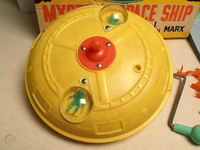Traveling Faster Than The Speed Of Light - A Rauchian Theorem
Time to reveal my secret to faster-than-light space travel
 |
 Marc Rauch |
Exec. Vice President/Co-Publisher
THE AUTO CHANNEL
When I was 18, more than half a century ago, I postulated that the speed of gravity was faster than the speed of light. And this deduction made me think of how a spaceship could travel at the speed of gravity (faster than the speed of light). Here's how I deduced all this: I imagined that a laser light briefly turned on and off (pulsed), and that as the light pulses or the beam moved forward it would be bent or otherwise distorted by gravity. In order for the pulses to be "captured" and distorted by gravity, the force of gravity had to move quicker than the light pulses could move. Therefore, gravity was faster than the speed of light.
 |
I then imagined that if the gyro could spin fast enough that it would become anti-gravitational. I likened the force of gravity and anti-gravity to different magnetic fields (like and unlike fields), which would instantly (at the speed of gravity) attract or repel each other. The result would be that the flying saucer would have the ability to be repelled from, or attracted to, a celestial body such as a planet at the speed of gravity.
From this, I had to work out how a flying saucer would be able to hover (not be instantly repelled completely away from a planet), how it could move gradually up and down, move horizontally, and what could possibly power the internal gyroscope to reach it's anti-gravitational speed.
I presumed then, and still maintain now, that a nuclear-powered engine would be used, and that a computer(s) would automatically and rather instantly adjust the speed of the spinning gyro to keep the ship steady to hover, increase to ascend, or decrease to descend. Moving horizontally or diagonally would be accomplished by slight tilts in the balance of the ship which would act somewhat similar to how a sailboat can move forward against a wind by tacking. The tacking actions would be so instantly controlled by the onboard computers that the minute zigzagging movements would appear to observers as being on a straight line.
I imagined that space travel would be possible by using the ship's anti-gravitational forces to repel from one planet or star towards another, and then ricochet from one to another - similar to how a ball in a pinball machine picks up speed as it bounces from one bumper to another.
I imagined that any onboard computer(s) could chart the cosmic path and make adjustments at the speed of electricity (the speed of light). Moreover, I imagined that cosmic knowledge and "charts" would be used to best determine when voyages could be made in order to use closely aligned bodies to bounce from one celestial body, thereby shortening the distances, and perhaps even multiplying the speed at which the ship could travel - twice the speed of gravity, three times the speed of gravity, etc., etc. In Star Trek vocabulary, Warp 1, Warp 2, Warp 3, and so on.
Somebody get Elon Musk on the phone!
Any thoughts or criticisms?


